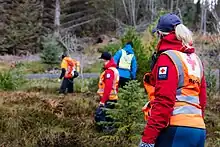Norwegian Red Cross Search and Rescue Corps
The Norwegian Red Cross Search and Rescue Corps or the NRCSRC/SRC (Norwegian: Norges Røde Kors Hjelpekorps) was created in 1932 as a support for civil society in the event of war, and particularly with gas attacks in other cities.


Today, there are over 300 local Search and Rescue Corps around in the country with over 6000 members. All members is qualified in search and rescue, and First Aid. The NRCSRC is one of the biggest agencies in norway doing voleentary rescue operations. Norway's entire rescue service is based on volunteerism. There is a professional rescue service, but this is reserved and ofen not enough to carry out the assignment.
The NRCSRC main task is to is to assist various national agencies. For example assist police in the search for missing person(s), assist the medical service to help a injured person down from a mountain or assist the Joint Rescue Coordinating Center to locate and assist lost persons in bad weather ect. In addition, the corps gives medical manpower to various events in the community (conserts, Soccer matches ect.), doing first aid instruction, and in some locations ambulance services to relive the local ambulance from transportation of an non-critical patient.
All efforts from the membership are voluntary. The equipment used is also paid for with funds collected through volunteer efforts.
Education
Anyone who wants to be an active member in the corps must complete a basic intruduction of Red Cross. They can then participate as an aspirant. When they have completed their full training of First Aid, Radio Communications, and Basic course in Search and Rescue, they are qualified members.
All members must pass a practical and theoretical examination in first aid and do a reassessment of all subjects every three years.
To be included in search and rescue operations, it is also required to train or have documented skills in outdoor activities, and search methods for summer and winter conditions. In addition, there are courses in water rescue, rescue in difficult terrain, the avalanche rescue, communications, advanced first aid, make-up and the cursor service, management, psychological first aid, ambulance and more.
Further education
The courses mention above is the basic training. After they can do more specialized training. Norway is a country with a lot of different terrain and what courses the local "SRC" is giving is depending where in the country the member lives.
Around in the country they have courses such as - ATV Operationas; Learning the skills to drive an ATV in different terrain, where you must always drive so that the patient is as gentle as possible
- Snowmobile Operations: Snow-activitys is a big thing in norway so learning the skills operating an snowmobile is crucial.
- Boating and water rescue; Some SRC's have small boats and some few places they got full size rescue vessel's. All crew on these boats no mater they are big or small have to have a basic courser in sea and water rescue. Are you the "Squad leader"/Captain u have to have more courses such as driving licens for boats, radio and a advance water rescue course.
- Advance First aider (AFA) / Expert First Aid (EFA): When you ar finished with Basic First aid, they can advance themself to Advence first aider course. This will make the member a better first aider and ofen is allowed to use more tools/equitment to give good firs aid. Further on they can advance even more to Expert First aider. This course give the member accsses to be a crew on and Red Cross Contingency Ambulance.
- Team Leader search and rescue: This is a course for those who is recommended to become a team leader for a search and rescue team.
- Operations Leader SAR: This is a course a memeber can take to become the Operation leader of an search and rescue mission. Together with other voluntary rescue services and the police, siting in the same room making planes for the teams that is field. They work together using statistics found in the book "Lost Persons Behavior" to make areas to search as efficiently as possible.
External links
- [https://www.rodekors.no/en/ Norwegian Red Cross